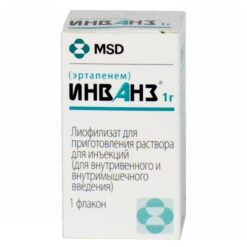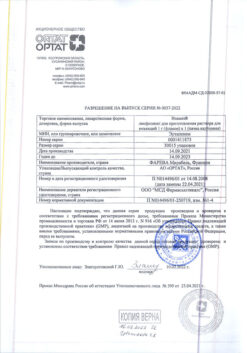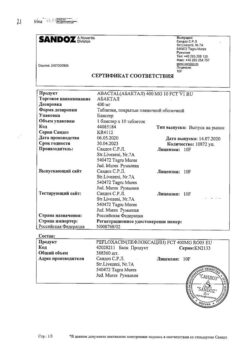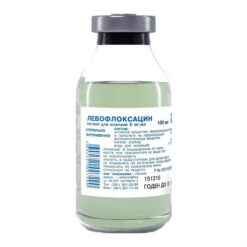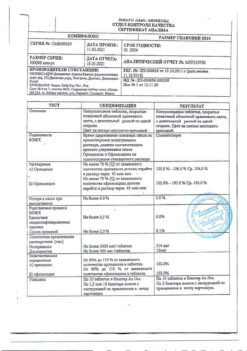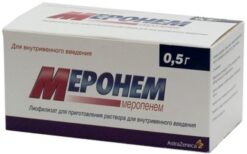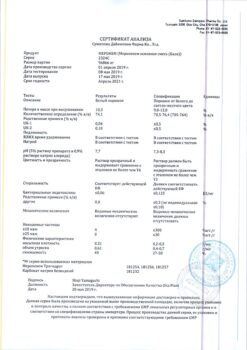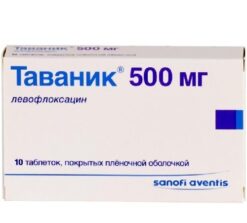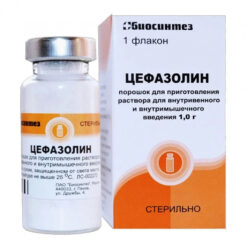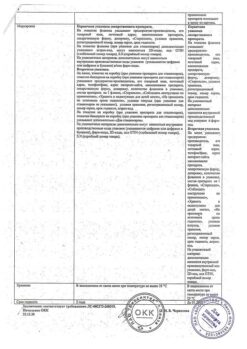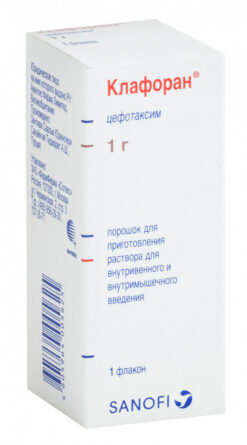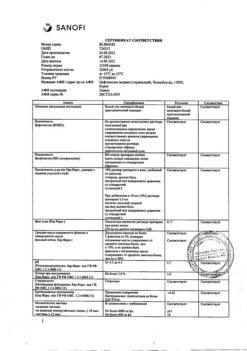No products in the cart.
Description
Pharmacological action – broad spectrum antibacterial, antituberculosis, bactericidal.
It actively penetrates through the cell membrane and irreversibly binds with specific receptor proteins on 30S ribosome subunit. Disrupts formation of the complex between matrix (informational) RNA and 30S ribosome subunit. This results in the misreading of information from RNA and the formation of incomplete proteins. The polyribosomes disintegrate and lose their ability to synthesize protein, which leads to the death of the microbial cell.
Active against the majority of Gram-negative and some Gram-positive microorganisms (MPC values, µg/ml are specified after the name of the microorganism): Pseudomonas aeruginosa (1.6-3.2), including those resistant to gentamic acid.including those resistant to gentamicin, tobramycin, sisomycin and netilmicin, Escherichia coli (1.6-3.2), Klebsiella spp. (1.6-6.4), Serratia spp. (1.6-6.4), Providencia spp. (1.6-6.4), Enterobacter spp. (1.6-3.2), Salmonella spp. (1.6-6.4), Shigella spp. (0.6-6.4), Streptococcus spp, Staphylococcus spp. (0.4-1.6), including those resistant to penicillin, methicillin and some cephalosporins, less active against enterococci. It is active against Mycobacterium tuberculosis and some atypical mycobacteria; it has bacteriostatic effect on Mycobacterium tuberculosis resistant to streptomycin, isoniazid, PASC and other anti-tuberculosis drugs (except viomycin and capreomycin). It has no effect on non-sporulating Gram-negative anaerobes and protozoa.
Resistance develops slowly, more than 70% of strains of Gram-negative and Gram-positive bacteria remain sensitive to amikacin. There is complete cross-resistance to the first generation aminoglycosides, to the rest – partial. Amikacin does not lose activity under the action of enzymes inactivating other aminoglycosides, due to which it can remain active against strains of Pseudomonas aeruginosa resistant to tobramycin, gentamicin and netilmicin.
It is practically not absorbed from the gastrointestinal tract. It is administered v/v or v/m. Cmax is reached 1 and 0.5 h after v/m and v/v administration at a dose of 7.5 mg/kg and is 21 and 38 µg/ml, respectively. Therapeutic concentration (15-25 µg/ml) is maintained for 10-12 hours in case of intravenous and intravenous administration. Along with netilmicin it is characterized by the most predictable Cmax and Cmin among aminoglycosides. Binding with plasma proteins is 4-11%.
The volume of distribution is 0.2-0.4 l/kg, in infants it is up to 0.68 l/kg. It easily passes through histohematic barriers and penetrates into lung tissue, liver, myocardium, spleen and bone tissue. It selectively accumulates in the cortical layer of kidneys and is distributed in extracellular fluid including serum, lymph, pleural, pericardial and peritoneal exudate, synovial fluid and abscess fluid.
In low concentrations it is determined in bile, bronchial secretion, muscle and fat tissue. It penetrates through the BBB, in case of inflammation of the cerebral membranes – to a greater extent. Higher concentrations in cerebrospinal fluid are achieved in newborns. It is not metabolized. T1/2 is 2-4 hours in adults and 5-8 hours in newborns. Renal clearance is 79-100 ml/min, with impaired renal function the T1/2 is increased to 70-100 hours. It is excreted mainly by kidneys (65-94%) in unchanged form by glomerular filtration, forms high concentrations in urine; a small amount is excreted with bile. It is excreted with hemodialysis (every 4-6 hours the concentration in plasma decreases by 50%) and to a lesser extent – with peritoneal dialysis (during 48-72 hours about 25% of dose is excreted).
When using amikacin the ototoxic effect is more pronounced (the auditory part of the VIII pair of cranial nerves is affected more often than the vestibular one) than the nephrotoxic effect. The probability of ototoxicity is higher with impaired renal function and dehydration, including burns. A single daily dose (80-100% of the standard dose) can reduce the risk of toxic effects while maintaining similar clinical efficacy.
The efficacy of intrathecal and intraventricular administration of amikacin in CNS infections has been reported, as well as the use of the solution for injection as inhalation.
In ophthalmology it can be used for local treatment of eye diseases – subconjunctival administration of amikacin solution (50 mg/ml); intravitreal 0.4 ml of solution (contains 0.4 mg/0.1 ml), the administration can be repeated at 3-day intervals.
Indications
Indications
Infectious and inflammatory diseases caused by gram-negative microorganisms (resistant to gentamicin, sisomycin and kanamycin) or associations of gram-positive and gram-negative microorganisms: respiratory tract infections (bronchitis, pneumonia, pleural empyema, lung abscess), sepsis (including those caused by strains of Enterobacteriaceae and Pseudomonas aeruginosa, resistant to other aminoglycosides), septic endocarditis, central nervous system infections (including meningitis), abdominal infections (including peritonitis), urinary tract infections (pyelonephritis, cystitis, urethritis), prostatitis, gonorrhea, purulent infections of the skin and soft tissues (including infected burns, infected ulcers and bedsores of various origins), biliary infections paths, infections of bones and joints (including osteomyelitis), wound infection, postoperative infections, otitis media.
Tuberculosis (reserve drug) – in combination with other reserve drugs.
Pharmacological effect
Pharmacological effect
Pharmacological action – broad-spectrum antibacterial, anti-tuberculosis, bactericidal.
Actively penetrates the cell membrane and irreversibly binds to specific receptor proteins on the 30S ribosomal subunit. It disrupts the formation of a complex between messenger RNA and the 30S ribosomal subunit. As a result, erroneous reading of information from RNA occurs, and defective proteins are formed. Polyribosomes disintegrate and lose their ability to synthesize protein, which leads to the death of the microbial cell.
Active against most gram-negative and some gram-positive microorganisms (MIC values, µg/ml are indicated after the name of the microorganism): Pseudomonas aeruginosa (1.6–3.2), incl. resistant to gentamicin, tobramycin, sisomycin and netilmicin, Escherichia coli (1.6–3.2), Klebsiella spp. (1.6–6.4), Serratia spp. (1.6–6.4), Providencia spp. (1.6–6.4), Enterobacter spp. (1.6–3.2), Salmonella spp. (1.6–6.4), Shigella spp. (0.6–6.4), Streptococcus spp., Staphylococcus spp. (0.4–1.6), incl. resistant to penicillin, methicillin and some cephalosporins, has a lesser effect on enterococci. Active against Mycobacterium tuberculosis and some atypical mycobacteria; has a bacteriostatic effect on Mycobacterium tuberculosis, resistant to streptomycin, isoniazid, PAS and other anti-tuberculosis drugs (except viomycin and capreomycin). Does not affect non-spore-forming gram-negative anaerobes and protozoa.
Resistance develops slowly; more than 70% of strains of gram-negative and gram-positive bacteria remain sensitive to amikacin. There is complete cross-resistance to first-generation aminoglycosides, and partial cross-resistance to the rest. Amikacin does not lose activity under the influence of enzymes that inactivate other aminoglycosides, due to which it can remain active against strains of Pseudomonas aeruginosa resistant to tobramycin, gentamicin and netilmicin.
Practically not absorbed from the gastrointestinal tract. Injected intravenously or intramuscularly. Cmax is achieved 1 and 0.5 hours after IM and IV administration at a dose of 7.5 mg/kg and is 21 and 38 mcg/ml, respectively. The therapeutic concentration (15–25 mcg/ml) is maintained for 10–12 hours with IM and IV administration. Along with netilmicin, it is characterized by the most predictable Cmax and Cmin among aminoglycosides. Plasma protein binding 4–11%.
The volume of distribution is 0.2–0.4 l/kg, in newborns up to 0.68 l/kg. Easily passes histohematic barriers, penetrates the tissue of the lungs, liver, myocardium, spleen, bone tissue, selectively accumulates in the renal cortex, is distributed in the extracellular fluid, including blood serum, lymph, pleural, pericardial and peritoneal exudate, synovial fluid, abscess fluid.
In low concentrations it is determined in bile, bronchial secretions, muscle and adipose tissue. Penetrates through the BBB, with inflammation of the meninges – to a greater extent. In newborns, higher concentrations are achieved in the cerebrospinal fluid. Not metabolized. T1/2 in adults – 2-4 hours, in newborns – 5-8 hours. Renal clearance 79-100 ml/min, with impaired renal function T1/2 increases to 70-100 hours. Excreted mainly by the kidneys (65-94%) unchanged by glomerular filtration, creates high concentrations in the urine; excreted in small quantities in bile. It is excreted during hemodialysis (every 4–6 hours the concentration in the blood plasma decreases by 50%) and to a lesser extent during peritoneal dialysis (approximately 25% of the dose is excreted within 48–72 hours).
When using amikacin, the ototoxic effect is more pronounced (the auditory part of the VIII pair of cranial nerves is more often affected by the vestibular one) than the nephrotoxic effect. The likelihood of ototoxicity is higher with impaired renal function and dehydration, including burns. A single daily dose (80–100% of the standard dose) reduces the risk of toxic effects while maintaining similar clinical efficacy.
There is evidence of the effectiveness of intrathecal and intraventricular administration of amikacin for infections of the central nervous system, as well as the use of an injection solution in the form of inhalation.
In ophthalmology, it can be used for local treatment of eye diseases – amikacin solution (50 mg/ml) is injected subconjunctivally; intravitreal – 0.4 ml of solution (contains 0.4 mg/0.1 ml), administration can be repeated at intervals of 3 days.
Special instructions
Special instructions
Before use, the sensitivity of microorganisms should be determined.
The solution for injection and infusion is prepared immediately before use. The contents of the bottle (0.25–0.5 g) are dissolved in 2–3 ml of sterile water for injection; for IV infusions, the resulting solution is diluted in 200 ml of 0.9% sodium chloride solution or 5% dextrose solution.
Active ingredient
Active ingredient
Amikacin
Composition
Composition
Amikacin (as sulfate) – 500 mg
Contraindications
Contraindications
Hypersensitivity, incl. to other aminoglycosides; damage to the auditory and vestibular apparatus of non-tuberculous etiology, incl. neuritis of the auditory nerve, impaired renal function (renal failure, uremia, azotemia), severe diseases of the heart and hematopoietic organs.
Side Effects
Side Effects
From the nervous system and sensory organs: headache, paresthesia, muscle twitching, convulsions, tremor, drowsiness, impaired neuromuscular transmission (muscle weakness, difficulty breathing, apnea), psychosis, hearing impairment (a sensation of “stuffing” or tinnitus, decreased hearing with a decrease in the perception of high tones, irreversible deafness) and balance (uncoordinated movements, dizziness, instability).
From the cardiovascular system and blood (hematopoiesis, hemostasis): palpitations, arterial hypotension, anemia, leukopenia, thrombocytopenia, granulocytopenia, eosinophilia.
From the gastrointestinal tract: nausea, vomiting, diarrhea, dysbacteriosis, increased activity of liver transaminases, hyperbilirubinemia.
From the genitourinary system: kidney damage (albuminuria, hematuria, oliguria, renal failure).
Allergic reactions: skin itching, urticaria, arthralgia, Quincke’s edema, anaphylactic shock.
Other: drug fever, pain at the injection site, dermatitis, phlebitis and periphlebitis (with intravenous administration).
Interaction
Interaction
There is physical and chemical incompatibility with penicillins, especially carbenicillin. Pharmaceutically incompatible with heparin, cephalosporins, amphotericin B, chlorothiazide, erythromycin, vitamins C and B, potassium chloride.
Shows synergy with beta-lactam antibiotics against many gram-negative microorganisms, with ticarcillin, azlocillin and piperacillin against Pseudomonas aeruginosa and other non-fermenting gram-negative bacteria. With the simultaneous and/or sequential use of two or more aminoglycosides (neomycin, streptomycin, kanamycin, gentamicin, monomycin, tobramycin, netilmicin), their antibacterial effect is weakened (competition for one mechanism of “capture” by the microbial cell), and the toxic effects are enhanced.
Amiloride reduces the nephrotoxicity of amikacin (by reducing penetration into the proximal tubules). When taken concomitantly with amphotericin B, cephalothin, polymyxin, cisplatin, vancomycin and nalidixic acid, the risk of nephrotoxicity increases.
Loop diuretics (furosemide, ethacrynic acid) and cephalothin increase ototoxicity. Indomethacin, when administered intravenously, reduces the renal clearance of amikacin and increases its plasma concentration and the risk of toxicity.
When used simultaneously with inhalation anesthesia agents, curare-like drugs, opioid analgesics, magnesium sulfate and polymyxins for parenteral administration, as well as with the transfusion of large amounts of blood with citrate preservatives, the neuromuscular blockade increases. Reduces the effectiveness of antimyasthenic drugs (their dose adjustment is required).
Overdose
Overdose
Symptoms: toxic reactions, neuromuscular blockade up to respiratory arrest, in infants – central nervous system depression (lethargy, stupor, coma, deep respiratory depression).
Treatment: intravenous calcium chloride, anticholinesterase drugs (neostigmine subcutaneously), m-anticholinergic agents (atropine), symptomatic therapy, and, if necessary, mechanical ventilation. Hemodialysis and peritoneal dialysis are effective in cases of impaired renal function; newborns receive exchange transfusions.
Storage conditions
Storage conditions
The drug should be stored out of the reach of children, in a dry place, protected from light at a temperature of 5° to 25°C.
Shelf life
Shelf life
2 years.
Manufacturer
Manufacturer
Kraspharma PJSC, Russia
Additional information
| Shelf life | 2 years. |
|---|---|
| Conditions of storage | The drug should be kept out of reach of children, dry and protected from light at 5 ° to 25 ° C. |
| Manufacturer | Kraspharma PJSC, Russia |
| Medication form | solution for injections and infusions |
| Brand | Kraspharma PJSC |
Related products
Buy Amikacin, 500 mg with delivery to USA, UK, Europe and over 120 other countries.


